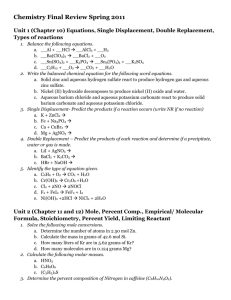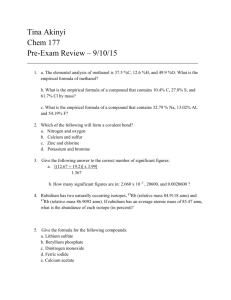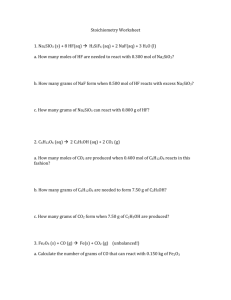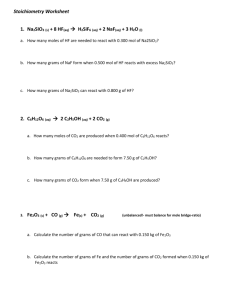Chapter 3: Stoichiometry: Calculations with Chemical Formulas and
advertisement
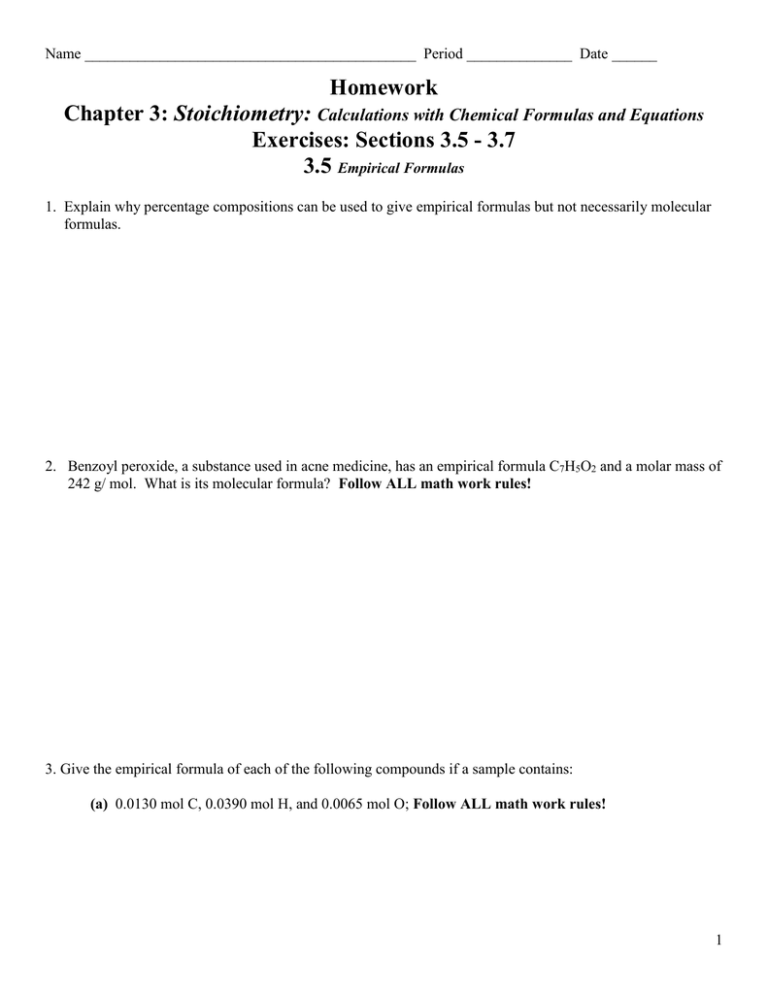
Name ____________________________________________ Period ______________ Date ______ Homework Chapter 3: Stoichiometry: Calculations with Chemical Formulas and Equations Exercises: Sections 3.5 - 3.7 3.5 Empirical Formulas 1. Explain why percentage compositions can be used to give empirical formulas but not necessarily molecular formulas. 2. Benzoyl peroxide, a substance used in acne medicine, has an empirical formula C7H5O2 and a molar mass of 242 g/ mol. What is its molecular formula? Follow ALL math work rules! 3. Give the empirical formula of each of the following compounds if a sample contains: (a) 0.0130 mol C, 0.0390 mol H, and 0.0065 mol O; Follow ALL math work rules! 1 3. Continued (b) 11.66 g iron and 5.01 g oxygen; Follow ALL math work rules! (c) 40.0 percent C, 6.7 percent H, and 53.3 percent O by mass. Follow ALL math work rules! 2 4. Determine the empirical formulas of the compounds with the following compositions by mass: (a) 32.79 percent Na, 13.02 percent Al, and 54.19 percent F; Follow ALL math work rules! (b) 62.1 % C, 5.21 % H, 12.1 % N, and 20.7% O. Follow ALL math work rules! 3 5. What is the molecular formula of each of the following compounds: (a) empirical formula HCO2, molar mass = 90.0 g/ mol; Follow ALL math work rules! (b) empirical formula C2H4O, molar mass = 88 g/ mol. Follow ALL math work rules! 6. Determine the empirical and molecular formulas of each of the following substances: (a) caffeine, a stimulant found in coffee, contains 49.5 percent C, 5.15 percent H, 28.9 percent N, and 16.5 percent O by mass; molar mass about 195 g. Follow ALL math work rules! 4 6. Continued (b) Monosodium glutamate (MSG), a flavor enhancer in certain foods, contains 35.51 percent C, 4.77 percent H, 37.85 percent O, 8.29 percent N, and 13.60 percent Na and has a molar mass of 169 g. Follow ALL math work rules! 5 7. (a) The characteristic odor of pineapple is due to ethyl butyrate, a compound containing carbon, hydrogen, and oxygen. Combustion of 2.78 mg of ethyl butyrate produces 6.32 mg of CO2 and 2.58 mg of H2O. What is the empirical formula of the compound? Follow ALL math work rules! 6 7. Continued (b) Nicotine, a component of tobacco, is composed of C, H, and N. A 5.250-mg sample of nicotine was combusted, producing 14.242 mg of CO2 and 4.083 mg of H2O. What is the empirical formula for nicotine? Follow ALL math work rules! (c) If the substance in (b) has a molar mass of 160 ± 5 g, what is its molecular formula? Follow ALL math work rules! 7 8. Epsom salts, a strong laxative used in veterinary medicine, is a hydrate, which means that a certain number of water molecules are included in the solid structure. The formula for Epsom salts can be written as MgSO4•xH2O, where x indicates the number of moles of H2O per mole of MgSO4. When 5.061 g of this hydrate is heated to 250oC, all the water of hydration is lost, leaving 2.472 g of MgSO4. What is the value of x? Follow ALL math work rules! 3.6: Calculations Based on Chemical Equations 1. What parts of balanced chemical equations give information about the relative numbers of moles of reactants and products involved in a reaction? 2. Hydrofluoric acid, HF(aq), cannot be stored in glass bottles because compounds called silicates in the glass are attacked by the HF(aq). For example, sodium silicate, Na2SiO3, reacts in the following way: Na2SiO3(s) + 8HF(aq) → H2SiF(aq) + 2NaF(aq) + 3H2O(l) (a) How many moles of HF are required to dissolve 0.50 mol of Na 2SiO3? Follow ALL math work rules (b) How many grams of NaF form when 0.300 mol of HF reacts in this way? Follow ALL math work rules! 8 2. Continued (c) How many grams of Na2SiO3 can be dissolved by 0.300 g of HF? Follow ALL math work rules! 3. Solid calcium hydride reacts with liquid water to form aqueous calcium hydroxide and hydrogen gas. (a) Write a balanced chemical equation for the reaction. (b) How many grams of calcium hydride are needed to form 5.0 g of hydrogen? Follow ALL math work rules! 4. (a) Write a balanced chemical equations for the complete combustion of octane. Don’t forget phases of matter! (b) How many moles of O2 are needed to burn 1.50 mol of C8H18? Follow ALL math work rules! (c) How many grams of O2 are needed to burn 1.50 g of C8H18? Follow ALL math work rules! (d) Octane has a density of 0.692 g/ mL at 20oC. How many grams of O2 are required to burn 1.00 gal of C8H18? Follow ALL math work rules! 9 5. Detonation of nitroglycerin proceeds as follows: 4C3H5O9N3(l) → 12CO2(g) + 6N2(g) + O2(g) + 10H2O(g) (a) If a sample containing 2.00 mL of nitroglycerin (density = 1.592 g/ mL) is detonated, how many total moles of gas are produced? Follow ALL math work rules! (b) If each mole of gas occupies 55 L under the conditions of the explosion, how many liters of gas are produced? Follow ALL math work rules! (c) How many grams of N2 are produced by the detonation? Follow ALL math work rules! 6. An iron ore sample contains Fe2O3 together with other substances. Reaction of the ore with carbon monoxide produces iron metal: _______Fe2O3 (s) + _______CO (g) → _______Fe (s) + _______CO2 (g) (a) Balance this equation. (b) Calculate the number of grams of Fe and the number of grams of CO2 formed when 0.150 kg of Fe2O3 reacts. Follow ALL math work rules! 10 3.7: Limiting Reactants; Theoretical Yields 1. (a) Define the terms i. theoretical yield ii. actual yield iii. percent yield iv. limiting reactant (b) Why is the actual yield in a reaction almost always less than the theoretical yield? 11 2. Solid aluminum hydroxide reacts with sulfuric acid(aq) to produce aqueous aluminum sulfate and liquid water. (a) Write a balanced chemical equation for this reaction. Don't forget phases of matter! (b) Which reactant is the limiting reactant when 0.500 mol aluminum hydroxide and 0.500 mole of sulfuric acid are allowed to react? Follow ALL math work rules! (b) How many moles of aluminum sulfate can form under these conditions? Follow ALL math work rules! (c) How many moles of the excess reactant remain after completion of the reaction? Follow ALL math work rules! 12 3. Gaseous ammonia reacts with oxygen gas to product gaseous nitrogen (II) oxide and water vapor. (a) Write a balanced chemical equation for this reaction. Don't forget phases of matter! (b) In a certain experiment 1.50 g of NH3 reacts with 2.75 g of O2 Which reactant is limiting? Follow ALL math work rules! (c) How many grams each of NO and H2O form? Follow ALL math work rules! (d) What mass, in grams, of excess reactant remains after the limiting reactant is completely consumed? Follow ALL math work rules! 13 4. Solutions of sulfuric acid and lead (II) acetate react to form solid lead (II) sulfate and a solution of acetic acid. A solution containing 7.50 g of sulfuric acid and 7.50 g of lead (II) acetate are mixed. (a) Write the balanced chemical equation for this reaction. Don't forget phases of matter! After the reaction has stopped calculate how many grams of each of the following are in the mixture. (b) the number of grams of sulfuric acid; Follow ALL math work rules! (b) lead (II) acetate; Follow ALL math work rules! (c) lead (II) sulfate; Follow ALL math work rules! (d) acetic acid ; Follow ALL math work rules! 14 5. When hydrogen sulfide gas is bubbled into a solution of sodium hydroxide, the reaction forms sodium sulfide and water. (a) Write a balanced chemical equation for this reaction. Don't forget phases of matter!! (b) How many grams of sodium sulfide are formed if 1.50 g of hydrogen sulfide is bubbled into a solution containing 2.00 g of sodium hydroxide, assuming that the sodium sulfide is made in 92.0 % yield? Follow ALL math work rules! 15 6. When ethane gas reacts with elemental chlorine the main products are C2H5Cl and hydrogen gas. (a) Write a balanced chemical equation for this reaction. Don't forget phases of matter!! (b) Calculate the percent yield of C2H5Cl if the reaction of 125 g of ethane with 255 g of chlorine produced 206 g of C2H5Cl. Follow ALL math work rules! 16

